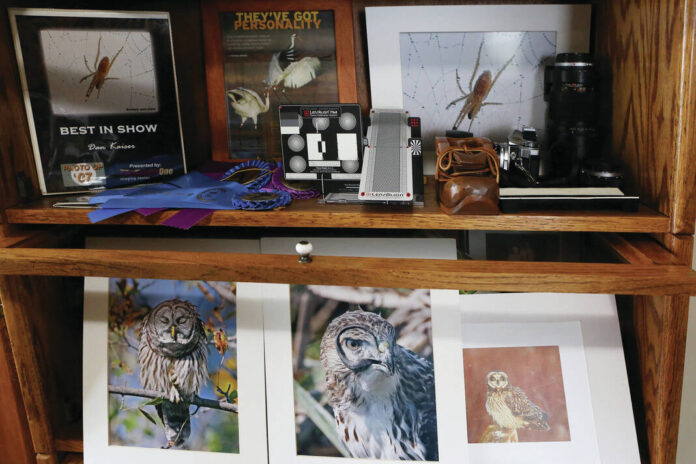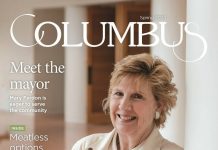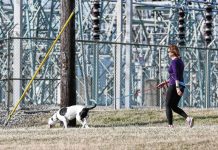
Photos, awards and ribbons for his work and miscellaneous photography equipment and objects on display in the study in Dan Kaiser’s home Tuesday, April 12, 2022. Carla Clark | For The Republic
Amateur photographer Dan Kaiser gets up before the run comes up. With photo gear packed in the back of his sport-utility vehicle, the Columbus man is eager to find out what wildlife will make its way next into the viewfinder of his Canon camera.
As the 73-year-old closes the back cargo hatch, the letters that make up his Army Veteran vanity license plate jump out like a rare Whooping Crane stepping into the brilliance of early morning light.
“OUCH,” the letters read, just above “PURPLE HEART” in smaller letters.
The message is a lighthearted hint into a serious time in the Indiana native’s life. Roughly 8,500 miles from home, inside an Army helicopter three months into his tour of duty, Kaiser’s crew in 1968 was exchanging fire with enemy North Vietnamese troops below.
“We had 14 rockets mounted on the outside of the aircraft, four external machine guns and two internal machine guns,” Kaiser said of the Vietnam War incident.
As co-pilot, it was Kaiser’s job to fire the hydraulically controlled external machine guns.
While holding the gun sight in both hands, Kaiser took a round of ammunition just above his left wrist, damaging tendons and skin. He spent 15 months healing at the now-closed Great Lakes Naval Hospital north of Chicago, the military care center closest to his home in Wabash, Indiana.
Kaiser was awarded the Purple Heart for injuries he sustained in combat, and presented the Distinguished Flying Cross, the Pentagon’s highest award for extraordinary aerial achievement.
While he recovered almost completely from his wartime physical injuries, Kaiser continues to experience post-traumatic stress disorder — a condition he has come to terms with. It altered his career path, with positive results, and opened the door to hobbies that have given him personal satisfaction.
The business management major at Ball State University decided during his junior year that he didn’t want to pursue a career in business management. While completing his degree program as planned, Kaiser looked for a post-graduation opportunity that would allow him to work by himself rather than in large groups of people.
Kaiser found one in a Muncie shoe-repair shop, where he was able to learn the trade.
“It was really happenstance. I was just looking for a job,” Kaiser said.
But working in solitude appealed to him, and in 1979 he moved to Columbus, where Kaiser’s Shoe Repair became the city’s fourth such business.
“Columbus was an attractive city and I had relatives here,” Kaiser said. “As other shops closed, I picked up business. As it turns out, I was the last man standing.”
Kaiser retired in 2012 while in his early 60s, a life step that opened up more time for hobbies that also provided solitude.
“When I get involved in something, I really get involved,” said Kaiser, thankful to have an understanding wife of 49 years in Barbara.
Astronomy became his first big hobby after Kaiser took an astronomy class at Ball State. His professor told class members about a visible comet and where they could find it in the sky. They wouldn’t need binoculars to see this comet’s bright tail.
“Naked comets come around once every 10 years. This one was very spectacular,” Kaiser said. “There has been nothing so bright since.”
A decade later, Kaiser purchased an 8-inch-diameter telescope, which came with a book that described how to identify a nova, or exploding star. It entailed taking photographs of the sky, then coming back later and photographing the same sky to see what changed.
The 35mm camera Kaiser used, his first, was a gift from his in-laws, Rudy and Evelyn Rejholec of New York.
In more than 5,000 photos that Kaiser took of the sky, he never did find a nova. But by using the telescope in the backyard of his northside Columbus home, Kaiser located dozens of variable stars, which change brightness over time.
One such finding Kaiser discovered photographically was OW Geminorum, an eighth-magnitude star at the feet of Gemini described by astronomy magazine writer Alan MacRobert in 1995 as “one of the largest and most luminous eclipsing binary systems known.”
Kaiser’s interest in astronomy led to his involvement in the American Association of Variable Star Observers, based in Cambridge, Massachusetts. It published his photographic discoveries, documented with Kaiser’s telescope, 35mm camera, a 135mm lens and slide film, developed in his bathroom. Kaiser later served 12 years on the organization’s board, including a term as president.
While Dan Kaiser was participating in meetings of the astronomy organization, Barbara Kaiser and other members’ spouses would go birding, the practice of hunting for birds and trying to identify what you see.
Birding would become a husband-and-wife activity for the Kaisers. But because identifying birds with unaided eyes was difficult for Dan Kaiser, in the late 1990s he began taking pictures of birds they came upon, identified later from photo prints.
Kaiser’s favorite places for birding became Muscatatuck National Wildlife Refuge near Seymour, about a half hour south of Columbus, and Lake Monroe, an hour west near Bloomington.
But rare birds can be found just about anywhere, with Kaiser’s unusual spotting of two snowy owls in Bartholomew County given as examples.
Kaiser has become especially interested in spotting and photographing Whooping Cranes, which pass through Indiana in the fall and spring. On the verge of extinction in the 1940s, they are the tallest and rarest birds in North America, with an estimated population of 800.
“It happened accidentally in 2006,” Kaiser said of his fascination with the rare species.
Kaiser had heard about the more abundant sandhill cranes migrating through Ewing Bottoms, near Brownstown in Jackson County. Having gone there to photograph sandhills, Kaiser found whooping cranes mixed in.
He took note of the rare crane’s colored leg bands, which along with radio frequencies are used to identify each individual Whooping Crane.
Kaiser reported the spotting to the International Crane Foundation, which at the time only had three people tracking Whooping Cranes on their migratory path between Wisconsin and Florida. In the 15 years since, Kaiser has continued to spot and report sightings of Whooping Cranes. The majority that come through Indiana stop at the Goose Pond Fish & Wildlife Area near Linton, he said.
The more Kaiser got into nature photography, the more he enjoyed it, expanding from birds to mammals to insects.
One species that presented a photographic challenge was the river otter, another tenant at Muscatatuck National Wildlife Refuge. It took a few years for Kaiser to understand their behavior.
Kaiser would see the otters out on the ice during winter, diving into holes to catch fish. He would wait until the nearsighted mammals went underwater, then kept moving closer until he was able to take pictures as they emerged with a fish in their mouths.
“The hunt to me is half the fun,” Kaiser said.
Sometimes he will head out to take pictures with a friend, Mike Briner, a semi-professional nature and travel photographer from Columbus, who has sold photos to dozens of clients. The pair got to know each other from Kaiser’s shoe-repair business, which had nature photos displayed on the walls.
As Briner was convalescing from injuries sustained in October 2009 when struck by a pickup truck on Interstate 65 while trying to capture a dog as a city animal control officer, Kaiser offered to take his friend around to shoot photos together.
Kaiser considers Briner, 62, a mentor, helping increase his knowledge of photo equipment and techniques, including lighting.
“The more you do it, the better you get,” said Briner, who works part-time at Columbus Regional Hospital in environmental services.
Sometimes the two meet up at Muscatatuck. In early April, they traveled to Louisville to photograph a great horned owl and her babies in the wild.
“He’d do anything in the world for you,” Briner said of Kaiser.
From 2018 to 2020, Kaiser volunteered at Our Hospice of South Central Indiana in Columbus, sharing camaraderie with hospice patients who served in the military.
Kaiser spent short but precious time with three of the veterans in their final days. With a fourth Hospice patient, it was well over a year before he succumbed.
They spoke a common language, Kaiser said, and as military veterans shared a brotherhood.




